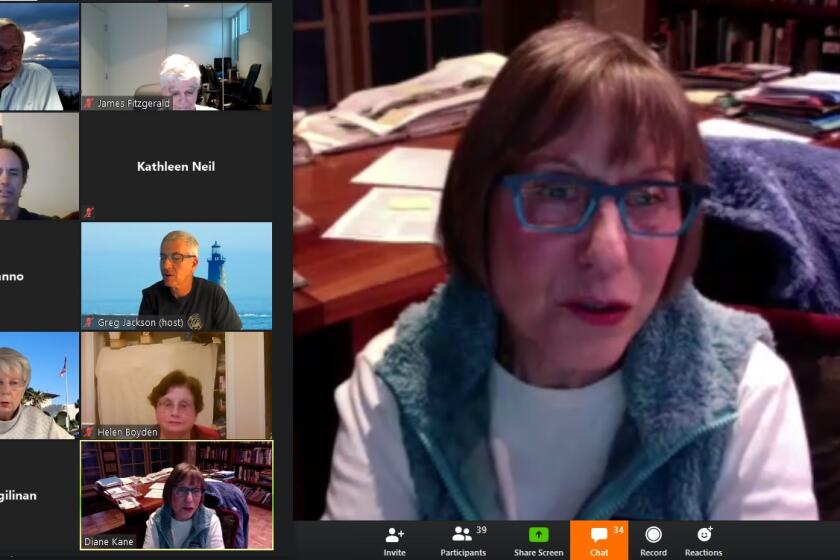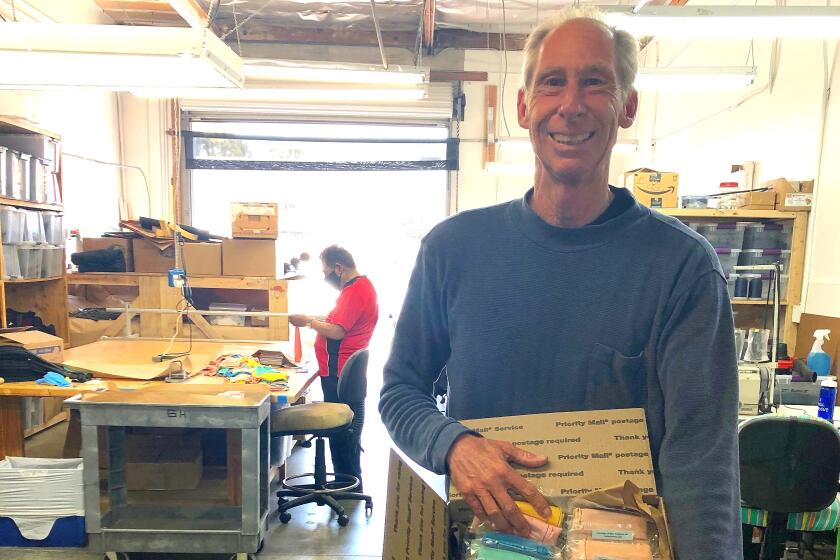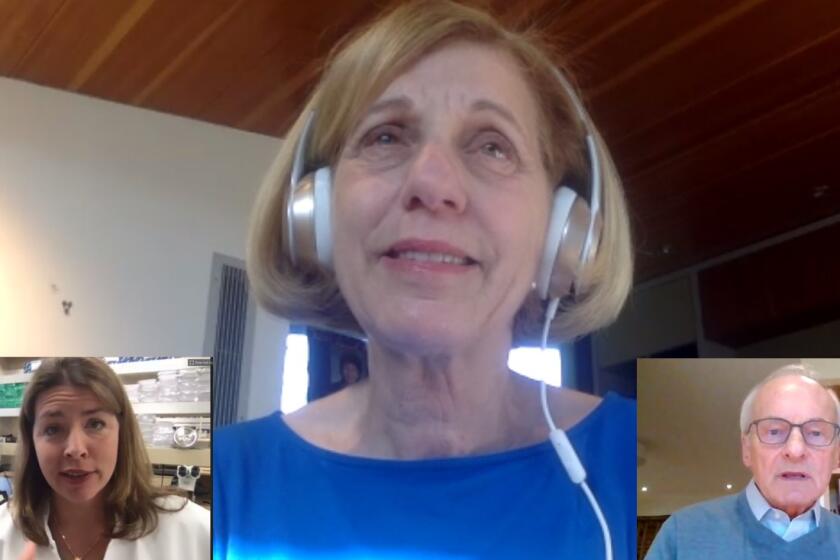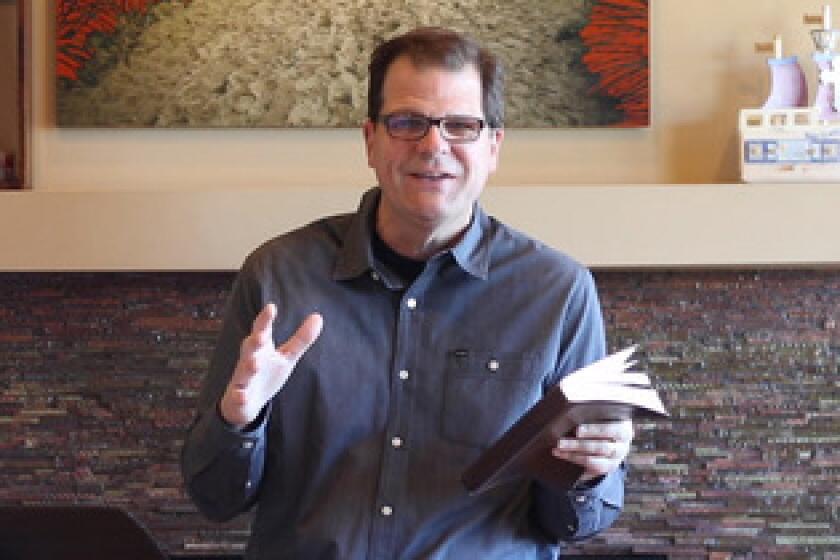People in Your La Jolla Neighborhood: Meet UCSD health researcher Steffanie Strathdee (and discover the health nightmare she lived through)
It’s not every day you meet someone who injected purified sewage into her husband to save his life. But, if Steffanie Strathdee has her way, the odds of such an encounter will greatly increase.
Strathdee, a native of Toronto, is the associate dean of Global Health Sciences in the Department of Medicine at UC San Diego. (She also holds the Harold Simon Chair in global health.) Basically, her job is to identify research and training opportunities that position UC San Diego to address the world’s most pressing health challenges. (Among her own research projects is a Tijuana program to study HIV prevention among injection drug users and sex workers.)
But, beginning in late 2015, the only the health crisis on Strathdee’s radar was the one in her personal life. Her husband, UCSD psychiatry professor Tom Patterson, fell suddenly and gravely ill while the couple was vacationing in Egypt. The infection spread from his abdomen to his blood and lungs and no antibiotic could touch it. Three months later, he lay dying at Thornton Hospital.
The culprit was Acinetobacter baumannii, the dreaded “Iraqibacter” bacteria first identified in Army medical facilities during the Iraq War. It now tops the international list of superbugs that are almost entirely immune to antibiotics. (Sometimes, a WWII antibiotic called Colistin still works, but not on Patterson.)
After her UCSD colleagues reported being out of options, Strathdee took research into her own hands and found a forgotten cure. Bacteriophages are viruses that naturally evolved to infect and kill bacteria. Phage therapy, invented more than a century ago, had been making headway against infections until just before World War II, when the discovery of penicillin rendered it obsolete. It is now a highly unconventional approach, and a very long shot, that required the researchers trying to save Patterson’s life to sample human poop from waste water-treatment plants around the world.
Sitting at her desk overlooking La Jolla’s academic mesa while recalling her nightmare, Strathdee runs through the gamut of emotions she felt at the time: fear, shock, desperation. But there’s a new one: gratitude. Had this case not happened to the loved one of a medical professional based at a research hospital, it would not have led to the breakthroughs in phage treatment that seem to lie ahead. The Patterson case has sparked a renaissance in the therapy.
Strathdee and Patterson are also writing a book about their experience, The Perfect Predator: A Scientist’s Race to Save Her Husband from a Deadly Superbug, to be published next May through Hachette Book Group. And Strathdee reports there is already interest in the film rights.
Is antibiotic resistance humankind’s next worst problem?
Yes. It’s growing. We have 2 million people in the U.S. getting superbug infections every year, and right now, 23,000 or so are dying, but that number is increasing. Bacteria are gaining the upper hand because they’re getting resistant to our overuse of antibiotics — mostly in livestock. Seventy percent of antibiotics in the U.S. are actually used to grow fatter pigs, cattle and chickens. That’s the big problem. It isn’t so much that humans are overusing antibiotics — although that’s a problem, too.
A guy just called me last week who’s likely to lose his foot because he stepped on a nail and has a bacterial infection that’s resistant to all antibiotics. So these things are happening more. What people in the know are saying is that we’re entering a post-antibiotic era where small infections like scrapes may not be treatable.
Even if we stopped now, would it be too late?
We’re going to see this problem for a while. Undoing what we’ve done, as a planet, is going to take a lot of time.
What was the first sign that something really bad was wrong with your husband?
He was vomiting uncontrollably for hours, but he has some crazy food allergies and a tender tummy, so I was not thinking it was really anything out of the ordinary. I thought it was food poisoning. I even had some Cipro with us, just gave him one and thought that it was all going to go away in a half an hour like it usually does. But it got worse. We were on a cruise ship, on our way to the Valley of the Kings, so we got a doctor to the boat. He gave him some IV antibiotics and fluid and said, ‘This always works’ and that he’d be up and about by dinner time.
He wasn’t. He was worse. His stomach was distended and hard and he started complaining about his back. So I contacted Chip Schooley, the head of infectious diseases here, and he said Tom needed to get to a hospital, because he could have a twisted bowel or pancreatitis, both of which are scary. So we were medevacked from Luxor to Frankfurt, Germany, where they diagnosed an abscess in his abdomen the size of a football. They found that he had lots of little gall stones that blocked his bile duct, which created the abscess. They found out that this fluid inside of it, which they expected to be clear if it had just recently formed, was putrid and brown and growing some kind of organism. So they cultured it and, a couple of days later, found what they called ‘the worst bacteria on the planet.’ They call it ‘Iraqibacter’ because so many vets are coming back from the Middle East with it.
My husband’s bacteria had 46 different resistance genes and acquired several more before he got medevacked back to the States in mid-December. By the end of January, he was in septic shock because they had put holes in this abscess to drain it out, and one of those drains slipped inside him and dumped all that infected fluid throughout his system.
You must have thought that was it.
Up until that point, we thought he was going to get strong enough to go to a long-term acute care facility. But from that moment on, we were losing. We didn’t have any antibiotics to kill this anymore, and I saw him slowly slipping away. By mid-February, we had the talk. I didn’t know if he could hear me, but I said, ‘I want to grow old with you, but if you don’t want to fight anymore, I’ll understand. But if you do, squeeze my hand and I’ll leave no stone unturned to try and find something that will kill this.’So he squeezed?
Yes. He was having this hallucination that he was a snake, I found out much later. He had these crazy hallucinations. But he squeezed my hand. So then it was like, ‘Great. What do I do now? If the best doctors in the world are not able to fight this, how am I going to be able to?’
How did you hit upon phage therapy?
I went to the internet and looked up alternative therapies for a superbug infection. And I found phage therapy. Just like every prey has a predator, every bacteria has a virus that attacks them naturally. We’re swimming in phage in our bodies. There are 30 million phages that go in and out of our body every day. So why not figure out which ones match the bacteria and use them to fight a superbug? But therapeutically using phages isn’t an everyday occurrence in the U.S. — especially using them intravenously, which is the way we had to go because Tom was fully colonized. It was in his sputum, in his bloodstream, everywhere.
How difficult was it to get UC San Diego to try it?
I wrote Chip Schooley an email that night and said, ‘I know we’re going to lose Tom unless we think outside the box.’ And he said, ‘If you can find some phages that match his bacteria, I’ll contact the FDA and see if we can get a compassionate release to give it to him.’ So I found some researchers who were studying phages. One at Texas A&M said he’d try to help but didn’t want to get my hopes up because it’s worse than looking for a needle in a haystack. He’d only found two in the last seven years that are active against this bacteria at all. But he wrote his people that he knew all over the world and we got offers from India, Switzerland, the Republic of Georgia and Belgium saying they’d send phages that maybe we’d match with. But we didn’t need just one phage, we needed a cocktail, because bacteria will multiply every 20-to-30 minutes and will become immediately resistant to the phages if there’s only one. Luckily, we found several — with help also from the U.S. Navy and a San Diego start-up called Ampliphi Biosciences.
How do you find phages?
Some of these phages came directly from sewage samples. If you have a gut organism that’s causing an infection, and there are phages in your gut, then you poop them out.
How fast did the FDA approve it for you?
Chip expected that he was going to have to explain what these things were, but the FDA knew all about them when he called. In fact, they were looking for opportunities to gather data. So now we had two cocktails, less than a month after my first email went out. And within a week of that, they were purified to the FDA’s specifications and sent back here. And that’s pretty fast when you compare them to an antibiotic that takes 10 years to develop.
So you just injected Tom and he got better?
That was the riskiest part, because it was either going to kill him or possibly cure him. But I knew that we didn’t have any other choice, because he was going to die anyway. And he woke up three days later from a coma, lifted his head off the pillow and kissed his daughter’s hand. He didn’t have any ill effects from the phages at all. And it just floored everybody in the ICU.
How do you view the whole experience in retrospect?
At first, we thought it was the most terrible thing that could have happened to us. And then, when Tom was in the hospital recovering, Chip came to us and said that a two-year-old was receiving phage therapy as a direct result of Tom’s case, and we both started crying. Since then, six other patients have gotten phage treatment intravenously and it’s revitalized interest in the therapy as a treatment for superbugs.
What is the state of bacteriophage research in the U.S.?
We’re trying to develop the first therapeutic phage institute in North America here at UCSD. Our tentative name is the Institute for Phage Applications and Therapeutics (IPATH). My husband was the first one treated here with phage therapy but we are treating a lot of patients right now with it. We are a place where we want to open our arms to patients with superbugs who get turned away from other hospitals, and what we need are some dedicated resources to ensure that doctors, nurses and staff are not having to reinvent the wheel with every new case.
How far away are we from that reality?
Right now, we’re fundraising, so at the very beginning. But I look at this as my global mission. The fact that this happened to us, and that all the planets had to line up in order for this to save him, makes us feel like this is the reason we’re on the planet.
So … how was Egypt otherwise?
Well, we never did see the Valley of the Kings! (laughs)
Get the La Jolla Light weekly in your inbox
News, features and sports about La Jolla, every Thursday for free
You may occasionally receive promotional content from the La Jolla Light.




